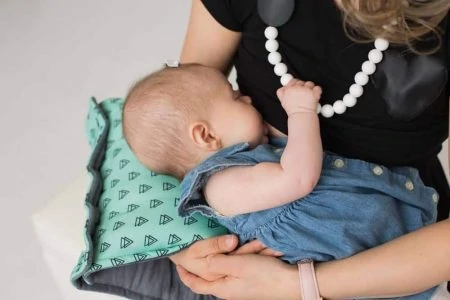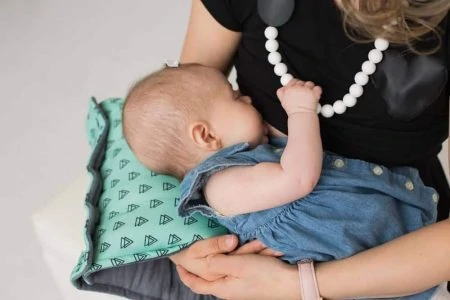Are you planning to breastfeed your baby? Then you’re probably expecting to save money. But while you’ll definitely save money on formula, those savings can quickly be eaten up the first time you go shopping for nursing clothes.
Thankfully, there are plenty of ways to outfit yourself for nursing that won’t break the bank, and we’ve tried them all! We’ve brought you our favorite tips for saving money on nursing clothes, so you can save that money for where it’s most needed.
Key Takeaways
- Nursing clothes are a niche market, so there are fewer producers of these clothes, which allows companies to charge higher prices.
- Nursing clothes are more complicated and require more materials to produce, which also contributes to their higher cost.
- To save money on nursing clothes, evaluate what you really need, think about how often you’re willing to do laundry, and look for sales or second-hand options.
- Consider nursing tops that can also be worn as regular tops, look for versatile pieces that can be dressed up or down, and consider investing in a few good-quality nursing bras.
Why Do I Need Nursing Clothes?
It’s possible to get by without nursing-specific clothes. To do so, however, is cumbersome and uncomfortable. Nursing clothes help make nursing easier by offering discreet built-in nursing panels that allow you to breastfeed or pump without completely disrobing.
Nursing tops and bras are also designed with a woman’s lactating breasts in mind. They typically have built-in elastic, allowing them to stretch to accommodate the changing size of your breasts throughout the day, as opposed to restrictive, inelastic fabrics that may be used for conventional clothes.
Many also have places to attach nursing pads, which are a necessity for nursing moms to prevent embarrassing leaks throughout the day.
Nursing clothes also act as an intermittent wardrobe between your maternity clothes and your pre-pregnancy threads. It can take many months to fit back into your old clothes. And despite what you’ve heard about breastfeeding being a great weight-loss plan after pregnancy, some women’s bodies continue to hold weight until they cease nursing. This reduces their likelihood of fitting into their old clothes until their nursing months are over.
Keep In Mind
Why Are Nursing Clothes So Expensive?
Nursing and maternity clothes are a niche market. There are fewer producers of these clothes, so companies have the luxury of charging higher prices because there aren’t as many competitors.
Further, manufacturers know they can play to women’s emotions. Breastfeeding is a selfless decision to give your baby the absolute best, and clothing companies know that your commitment doesn’t stop at your wardrobe choices.
Finally, nursing tops are more complicated and require more materials to produce. The cuts are different and more complex to provide modesty while breastfeeding, and the addition of nursing panels and clasps require extra materials.
How Can I Save Money on Nursing Clothes?
Even though nursing clothing pieces are justifiably higher priced, and it really will benefit you to pick some up, that doesn’t mean you have to spend top dollar. Here’s how to cut your costs.
1. Evaluate What You Really Need
Think long and hard about what you need for nursing. If you’re home most of the time, modesty might not be your utmost priority. You might need fewer tops than if you frequently leave the house, or you could get by with a couple of night-nursing bras instead of an entire collection of more expensive regular nursing bras.
Also, consider how frequently you’re willing to do laundry. If you can wash clothes a couple of times a week, you don’t need as many pieces as you will if you only do so weekly.
It’s tempting to think you need a ton of clothes to get through the nursing months, but with a few well-selected pieces, it’s possible to have a fully functional wardrobe with fewer items than you think.
Make a list of all the things you need — including nursing bras, camis, pajamas, and tops — and only purchase what’s on your list. This will ensure you get everything you need and will keep you from impulse buys.
2. Shop Second Hand
While thrift and consignment shops might not have the same wide selection as a maternity retail store, they often have a lot of well-priced choices. Because you only use nursing clothes for a short time, they’re usually still in great shape when they hit the secondhand market.
Some great places to scope out secondhand maternity clothes include the following:
- Thrift stores.
- Consignment stores — especially baby/kid consignment stores.
- Craigslist.
- OfferUp.
- Facebook Marketplace.
- eBay.
If you have old maternity clothes or baby gear that you no longer plan to use, you can cut your costs even further by consigning them and using your sales credit toward purchasing nursing tops. You typically get more in purchase credit than cash when you consign, so doing so cuts your costs even further.
3. Make Your Own
If you’re crafty — or even if you’re not — you can DIY some of your nursing clothes. There are many tutorials on how to make your own for a variety of skill levels. Here are some of our faves.
How to Make Your Own Nursing Bra
If you already have a bra that fits, you can convert it to a nursing bra with a few simple steps.
All you need is a length of elastic, nursing clasps, and a needle and thread. If you have a sewing machine, it will get the job done much more quickly.
To convert your old bra into a nursing bra:
- Choose a bra that has thick, supportive straps and is comfortable.
- Use scissors to cut the strap about an inch above the cup.
- Feed the strap through the bottom of the clasp and loop it, securing it again at the top of the cup.
- Thread the elastic through the top part of the clasp and secure it.
- Hook the two parts of the clasp together and run the elastic down through the bra cup. Secure it at the bottom of the cup and cut off the excess.
- Re-attach the cut edge of the original bra strap to the nursing clasp.
How to Make Your Own Nursing Tank
This no-sew tutorial uses an old tank top to make a free underlayer nursing tank.
With no special skills or tools required, all you need are a pair of scissors and an old tank top to make a modest layering piece that won’t cost you a dime.
Instructions:
- Lay an old tank top face-up and flat on a table.
- Snip a quarter-inch hole in the tank where the bodice meets the straps.
- Cut off the straps.
- Flip the tank over and cut off the upper part of the back so it’s even with the front.
- To wear it, slip the nursing panel clasps of your nursing bra through the holes in the cami and fasten them to secure the tank to the bra.
Make Your Own Nursing Cover
You can turn nearly any blanket into an instant nursing cover by tying two corners together behind your neck.
However, with just a little more effort, you can make a nursing cover that does double duty as a fashionable scarf. All you need is a piece of fabric, a pair of scissors, thread, and basic sewing skills.
To make your own nursing cover:
- Buy or cut a piece of breathable fabric 23” x 43.”
- Sew the long edges to prevent fraying. (TIP: If you choose a knit fabric, it will not fray. If you choose cotton or linen, you could use a product like Fray Stop instead of sewing.)
- Turn the fabric so the right sides are facing together and sew the short sides together.
- Cut off the excess fabric.
- Turn your scarf/cover right side out.
If you want to make your own nursing gear but feel like you lack the skills, ask a friend or family member who’s a little more talented in the DIY department to help you out.
4. Borrow From Friends
Sometimes you’re lucky enough to have friends going through pregnancy and motherhood at the same time as you. But more frequently, your journeys are staggered, and you’re pregnant while they’re wrestling a toddler, or you’re nursing while they’re contemplating whether to have another child.
If you have a friend who has nursed a child but isn’t currently breastfeeding, ask if you can borrow some of her pieces. More often than not, she’ll be delighted to help — and she’ll also know that she can count on you for maternity, nursing, or baby gear she doesn’t want to buy down the road.
5. Use a Coupon
We get it. Shopping for sales and couponing can be a pain. And unless you’re already a money-saving pro, we’re not advocating that you go to great lengths. But sometimes, you want a very specific wardrobe piece and need the full array of options from a major retailer.
When you do, always check Retailmenot.com before you check out. With both online and in-store coupons for places like Motherhood Maternity and A Pea in the Pod, it’s a one-stop search engine for all available coupons and will help you shave at least a few dollars off your nursing gear splurge.
Ebates is another great website if you’re shopping online. Not only does Ebates scour the internet and automatically apply the best coupon to your cart, but you also get cash back on your purchases made via an Ebates-opened shopping trip!
6. Opt for Layers
Nursing tanks and camis can be your best friends when you’re breastfeeding. They make great base layering pieces and can make it possible to use regular, versatile clothing pieces instead of traditional nursing tops.
Wear a cami beneath a regular sweater, low-cut top, versatile cardigan, or button-down shirt to transform nearly any top into a nursing-friendly wardrobe piece.










